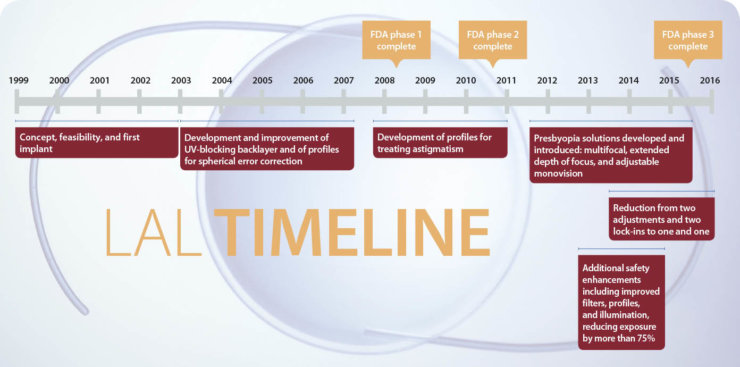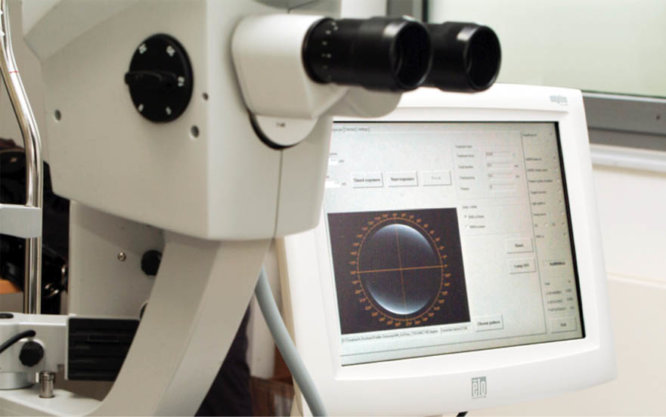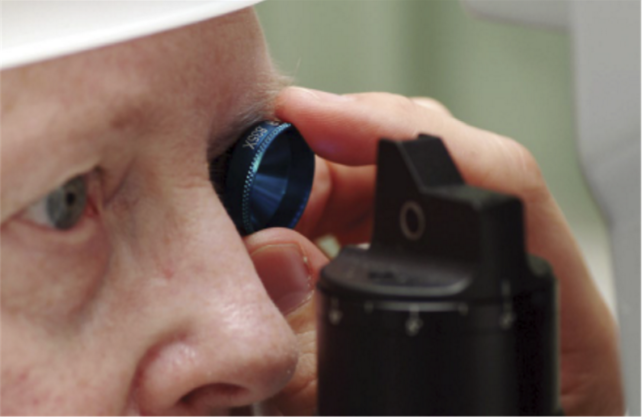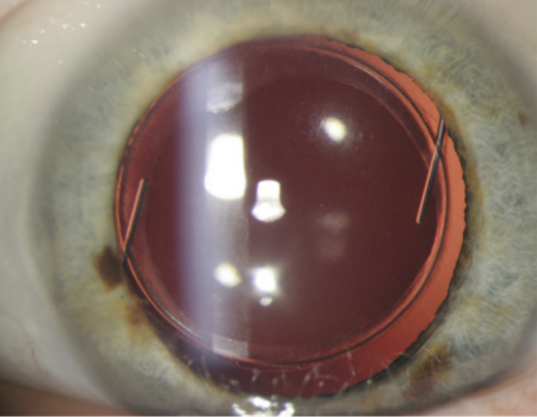I have performed more than 400 cataract surgeries in which I implanted the Light Adjustable Lens (LAL; Calhoun Vision).1-9 My first exposure to this IOL technology was in April 2008, during my tenure at Ruhr University in Bochum, Germany. Because of successful results there, I continue to implant the LAL now that I am on the faculty at Goethe University in Frankfurt, Germany. I am still fascinated by the possibility to safely, precisely, and noninvasively change refractive values inside the eye using specified amounts of UV light.


Figure 1. Touchscreen of the Digital Light Delivery Device, showing a combined spheric and toric profile.
Many centers have reported good results with the LAL,10-16 and several key improvements in the lens’ design have helped to ensure that patients now achieve even better visual outcomes. One of the biggest advantages compared with multifocal and accommodating lens technologies is the LAL’s potential to customize lens power postoperatively, thereby shifting the focus of refractive predictability away from developing more accurate IOL power formulas.

Figure 2. This patient is ready for the postoperative adjustment; a contact lens is in her eye.
THE PROCEDURE
The LAL, which can be implanted through a 2.9-mm incision during standard cataract surgery, is currently available in powers from 10.00 to 30.00 D (15.00–25.00 D in 0.50 D steps; 10.00–15.00 D and 25.00–30.00 D in 1.00 D steps). The lens reaches its final position in the capsular bag by about 2 weeks after implantation. Once the cornea stabilizes, primary adjustments can be made to address residual refractive errors of up to 2.00 D of sphere and cylinder (Figure 1). Because all refractive adjustments are done under active fixation with the eye stabilized by a contact lens (Figure 2), and because changes are applied according to the line of sight, decentration and lens tilt are not concerns.
Patients benefit from the precise postoperative adjustments of lens power, and all of the eyes I have treated are within ±0.25 D of target refraction. Furthermore, I can alter the lens to simulate monovision and other refractive situations before the lock-in procedure, so that the patient can experience different visual systems in daily life before committing to one.

Figure 3. The LAL 18 months after implantation and adjustments.
ADDITIONAL VISION SOLUTIONS
In addition to excellent long-term stability (more than 18 months; Figure 3) in regular, highly myopic, and hyperopic eyes, I am able to offer additional near and intermediate vision solutions for my patients. For example, I can enhance depth of focus with an induction of asphericity. This profile provides excellent distance and intermediate visual acuity in the dominant eye, independent of pupil size. The nondominant eye can then be adjusted for intermediate and near visual acuity.
Even with this enhanced profile, monocular distance visual acuity does not decrease below 20/30 in healthy eyes.
CONCLUSION
Currently, the LAL is the only available IOL that can be adjusted noninvasively and according to patient expectations and needs postoperatively. I recommend this IOL not only for regular cataract patients, but especially for those who have a history of corneal refractive surgery such as LASIK or PRK. In these eyes, IOL calculation is challenging, and patient expectations are difficult to fulfill without any postoperative means of further refractive adjustment. Patients appreciate the additional time required for consultations after surgery with the LAL, and they do not mind paying more for the benefits that this adjustable lens technology can provide in terms of enhancing their quality of life.
1. Hengerer FH, Böcker J, Dick BH, et al. Light adjustable lens. New options for customized correction of presbyopia [article in German]. Ophthalmologe. 2012;109(7):676-682.
2. Heinzelmann S, Hengerer FH, Maier P, et al. Is there an endothelial cell toxicity of light-adjustable lens UVA irradation on the human corneal endothelium? Eur J Ophthalmol. 2012;22 Suppl7:S57-S61.
3. Hengerer FH, Conrad-Hengerer I, Buchner SE, et al. Evaluation of the Calhoun Vision UV light adjustable lens implanted after cataract removal. J Refract Surg. 2010;26:716-721.
4. Hengerer FH, Conrad-Hengerer I, Hütz WW, et al. Adjustment of sphero-cylindrical refractive errors in hyperopic eyes: Six months after cataract surgery and implantation results of a light-ALPA adjustable intraocular lens [article in German]. Klin Monatsbl Augenheilk. 2010;227(9):729-734.
5. Hengerer FH, Hütz WW, Dick HB, et al. Combined correction of sphere and astigmatism using the light adjustable intraocular lens implanted in eyes with axial myopia. J Cataract Refract Surg. 2011;37(2):317-323.
6. Hengerer FH, Hütz WW, Dick HB, et al. Combined correction of axial hyperopia and astigmatism using the light adjustable intraocular lens. Ophthalmology .2011;118:1236-1241.
7. Hengerer FH, Dick HB, Conrad-Hengerer I. Clinical evaluation of an ultraviolet-light adjustable intraocular lens implanted following cataract removal: 18 months follow-up. Ophthalmology. 2011;118:2382-2388.
8. Conrad-Hengerer I, Dick HB, Hütz WW, et al. Optimized constants for the UV adjustable intraocular lens. J Cataract Refract Surg. 2011;37:2101-2104.
9. Hengerer FH, Dick HB, Buchwald S, et al. Evaluation of corneal endothelial cell loss and corneal thickness using light-adjustable intraocular lens technology following cataract removal: 12 months follow-up of 122 eyes. J Cataract Refract Surg. 2011;37:2095-2100.
10. Villegas EA, Alcon E, Rubio E, et al. Refractive accuracy with light-adjustable intraocular lenses. J Cataract Refract Surg. 2014;40(7):1075-1084.
11. Villegas EA, Alcón E, Mirabet S, et al. Extended depth of focus with induced spherical aberration in light-adjustable intraocular lenses. Am J Ophthalmol. 2014;157(1):142-149.
12. Brierley L. Refractive results after implantation of a light-adjustable intraocular lens in postrefractive surgery cataract patients. Ophthalmology. 2013;120(10):1968-1972.
13. Hengerer FH. Current state of the “light-adjustable lens” [article in German]. Klin Monbl Augenheilkd. 2012;229(8):784-793.
14. Kohnen T. Optimisation of lens replacement with light-adjustable intraocular lenses and aspects of postoperative complications from modern artificial lenses [article in German]. Klin Monbl Augenheilkd. 2012;229(8):783.
15. Rocha G, Mednick ZD. Light-adjustable intraocular lens in post-LASIK and post-traumatic cataract patient. J Cataract Refract Surg. 2012;38(6):1101-1104.
16. Lam S. Optimized constants for an ultraviolet light-adjustable intraocular lens. J Cataract Refract Surg. 2012;38(5):923-924; author reply 924.


